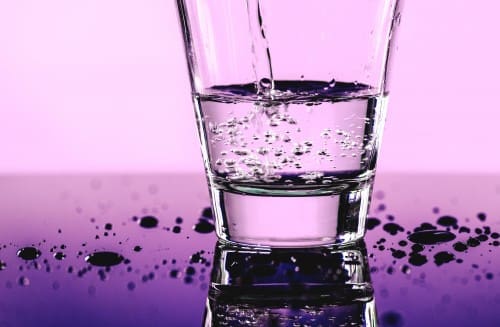Got Chloramine In Your Water? We remove that.
AquaOx Chloramine Filter
What is Chloramine?
Chloramines are disinfectants used by water utilities since 1930 in the treatment of drinking water in the United States of America.  They are derivatives of ammonia by substitution of either one to three hydrogen atoms with chlorine atoms.
They are derivatives of ammonia by substitution of either one to three hydrogen atoms with chlorine atoms.
The chemical is an unstable colorless liquid with a melting point of -66 degrees C (-87 degrees F). Monochloramine (chloramine) is an inorganic compound used as a disinfectant in water supplies and swimming pools.
Water with chloramines must meet EPA regulatory standards to be considered safe to use for drinking water, cooking, bathing, and other household uses. According to studies, more than one in five Americans uses drinking water, cooking, and bathing water treated with chloramines.
How Effective is Chloramine?
Chloramine is a chlorine-based compound that also contains ammonia to treat dirty water effectively. It is the only disinfectant that can kill pathogens without altering the quality of water, making it safe for human consumption. However, the process is slow.
According to Scientific American, chloramine disinfectant works as follows:
Chloramine disintegrates the cell wall barrier
Microorganism cells discharge vital constituents needed for their survival
It terminates their functionality and stops the reproduction
Even though it is highly effective, chloramine is a secondary disinfectant and is added at the end of the entire water treatment cycle, including coagulation, clarification, sedimentation, and filtration.
As a secondary disinfectant, it removes bacteria from the water that accumulates while moving through pipes. It effectively kills harmful organisms, especially those that lead to Legionnaire disease.
According to CDC, chloramine has been used since 1929 as a secondary disinfectant in the US, Canada, and the UK. It offers long-lasting protection as chloramine doesn’t dissipate as quickly as chlorine. Besides, it also produces fewer by-products that can negatively impact human health. Yet there are many chloramine removal processes to get rid of its distinct chemical taste from your water supply.
What Types of Industrial Uses Does It Have?
Chloramines are known as secondary disinfection and commonly used to treat drinking water. They are often formed when ammonia is added to chlorine during water treatment.
Chloramines are also used in swimming pool disinfection and are responsible for the chlorine smell of swimming pools. As secondary disinfection, chloramines provide long-lasting disinfection to households. In the United States of America and different parts of the world, public water systems use chloramines instead of chlorine to meet disinfection byproduct requirements.
Monochloramine has been a drinking water disinfectant for over 90 years. Since Monochloramine provides long-lasting protection and effective disinfection, the chemical is used to maintain good water quality in the pipes in America and different countries worldwide.
Monochloramine is a good primary disinfectant compared to chlorine in limited situations. The colorless liquid does an effective job of killing most of the potentially harmful microorganisms found in your drinking water. It is also an effective secondary disinfectant when used correctly. Monochloramine provides many advantages over chlorine as a secondary disinfectant.
Does Chloramine Affect The Taste and Smell of Drinking Water?
Like chlorine, chloramine will also affect the taste and smell of your drinking water primarily because it contains chlorine. Secondly, chloramine takes longer to dissipate and thus will have more pronounced and distinct characteristics.
However, if the lingering chemical odor and taste affect you, consider using a water filter for a better and fresher water quality. There are several methods for chlorine and chloramine removal from your water, but reverse osmosis is one of the most effective water filtration processes.
How Chloramine Affects Pipes And Rubber In A House

The use of water additives can increase some plumbing issues in your home. Chloramines are found to cause leaks in pipes, especially in copper pipe systems. The use of water treatment such as chloramines can cause lead to leach from pipes in your house.
Chloramines have a corrosive effect on your pipes and aggressively react with rubber compared with chlorine. Since water additives like chloramines can change the chemical properties of water, pipe systems like lead and copper pipes are affected.
Changes in the chemical properties of water may affect your health in the long run. If your municipal water supplier uses additives like chloramines in your tap water, then don’t be surprised if you experience drastic changes in your water quality.
How Does Chloramine Get Into Your Drinking Water?
Chloramine is directly added to your drinking water through the water treatment system to eliminate potential threats to your health. The chemical immediately kills bad microorganisms like bacteria before they reach households.
It is one of the most popular alternatives to chlorination, so you get healthy and safe drinking water right into your taps. Monochloramine is commonly used for water treatment but only as a secondary disinfectant, meaning most water impurities are already removed.
However, chloramine protects the water from recontamination with pathogens that may enter as water travels from facilities to household water taps. Since it is difficult to break down, chloramine can maintain water hygiene during long journeys.
As EPA has become more stringent on disinfection byproducts, the dependence on chloramine has grown over time.
What Are The Health Risks Associated with Chloramine?
Regular exposure to chloramines may lead to dry mouth and throat and eventually bleeding lips. Long-term exposure to chloramine-contaminated water irritates and damages the individual’s skin cells.
Chloramine can pose a serious health risk due to its notorious irritant and corrosive properties. Below we discuss the most prominent disadvantages of chloramine disinfection:
Chloramine Filter Overview
*NOTE: Not all water contains all contaminants discussed. No water purifying system can remove 100% of every contaminant. If you have a concern about a specific contaminant, please call us or live chat with one of our water experts.
AquaOx Removes These Elements And More
-
Water Filters
AquaOx Whole House Water Filter
$3,499.00 – $4,999.00 Select options This product has multiple variants. The options may be chosen on the product pageRated 4.94 out of 5
Irritates Skin and Eyes
Chloramine is potentially dangerous for people with sensitive skin. It dries out body oils, making our skin extremely dry, damaged, and irritated. Besides, it can exacerbate skin diseases such as eczema and acne. Continuous exposure to the chemical can cause a burning sensation, dryness, and redness in the eyes.
Triggers Sinuses
People allergic to chloramine can experience stinging, bloodshot eyes after showering. It is because inhaling chloramine vapors irritates your nasal passage and mucus membrane, thus reaching the sinus.
Changes The Taste Odor of Drinking Water
Chloramine has a lingering chemical taste, just like chlorine. Due to its strong chemical properties, chloramine itself takes a long time to wick away, thus leaving behind disinfection byproducts. Therefore, many use a water filter pitcher for chloramine reduction.
Destructs Rubber and Metal Pipes
Chloramines deteriorate the rubber, which frequently breaks down O-rings, gaskets, and seals in our taps. Furthermore, it also corrodes metal pipes as the ammonia in the water turns into nitrates. This leads to constant water leakage that requires costly maintenance work. Besides, it can also introduce new toxic chemicals such as lead, especially when adequate corrosion control is not implemented.
Toxic For Fish and Plant Health
Using chloramine-contaminated water in your fish tanks, aquarium and garden can be fatal for your flora and fauna. Fishes, especially, have a delicate internal organ system that is highly sensitive to chloramine. Exposure to this potent chemical can deprive the fishes and plants of essential nutrients and result in death.
Why You Are Most Exposed to Chloramine through Shower Water
The use of chloramine-contaminated water in the shower increases the risks of health effects. Since your water heater is affected by the water additive, your eyes, skin, and respiratory system are prone to chloramine’s health threats whenever you shower.
Do I Need A Shower Filter to Remove Chloramine?
While chloramine is an effective water disinfectant, it can make our hair and skin extremely dry and sensitivity-prone. Therefore, you need to remove the residual chlorine components before they come in contact with your body.
Shower filters are the most effective and affordable for reducing chloramine levels in your household tap water supply. They are installed in the shower head to treat the water before you bathe.
Since chloramine is a stronger disinfectant, it is harder to remove compared to free chlorine radicals. Search for the best chloramine water filters that can remove more than 70% of the water contaminants and chloramine content from the shower water.
You can even install whole house water filters, as it not only filters your drinking water but also acts as a shower filter.
The Solution to Eliminate Chloramine in Your Drinking Water
The best solution to remove chloramines in your feed water is by installing an effective water filtration system. AquaOx’s whole house water filters are a reliable water treatment technology that can remove chloramine and other contaminants. Install your filtered water system today and increase your family’s protection against pollutants.
With the AquaOx whole house water filter, you won’t have to do any maintenance or purchase a replacement filter cartridge since they are designed to last 20+ years.
Why You Need a House Filtration System for Chloramine Removal
Chloramine is a combination of chlorine and ammonia. Adding chloramine as a disinfectant to the water supply can increase exposure to lead in drinking water, especially in areas with older housing. This exposure can result in increased lead levels in the bloodstream and can pose a significant health risk. An activated carbon filter that aids in chloramine reduction is a wise investment.
There is also evidence that exposure to chloramines can contribute to respiratory problems, including asthma. The AquaOx systems with activated carbon filters can remove the harmful chloramine from your city water and keep your body going strong.
Does Boiling Water Remove Chloramine?
As we know, chloramine stays in the water for longer periods compared to chlorine. Therefore, chloramine just doesn’t evaporate from water even when left in the open air for a couple of days. Boiling may work, but the process is too slow. You would need to brew the water for at least an hour for chloramine reduction.
This means chloramine removal through boiling takes 10 times more than chlorine reduction. However, the water will be safe for consumption after boiling. Granular activated carbon or gac filter systems are much more effective in removing chloramine.
Chloramine Filter Overview
You can even consider one of the following chlorinated water filters to remove toxic metal and volatile organic compounds.
Catalytic Carbon Filters
The best shower filter uses catalytic carbon to remove harmful chemicals from the shower water. The altered electronic structure of the carbon breaks down both chlorine forms for better water quality. Catalytic carbon is generally used in whole-house filters.
Activated Carbon Filters
The gac carbon media adsorbs chlorine components and disinfection byproducts to remove water hardness. However, the carbon filter media becomes ineffective for chloramine as it requires extensive contact time.
Reverse Osmosis Filter
The RO process alone doesn’t remove chloramines, but the reverse osmosis system contains a sediment filter for effective results. The clean water production cycle is too slow, which means water and its contaminants interact with the carbon membrane for a long time. The activated carbon filter removes chlorine and other chemical residues only if the water flow rate is slow.
Brita Filters
Brita filters remove chloramine, lead, and other contaminants by using carbon filtration processes. When the water passes through carbon membrane, it adsorbs chlorine molecules and other organisms, making your water taste and smell fresher.







